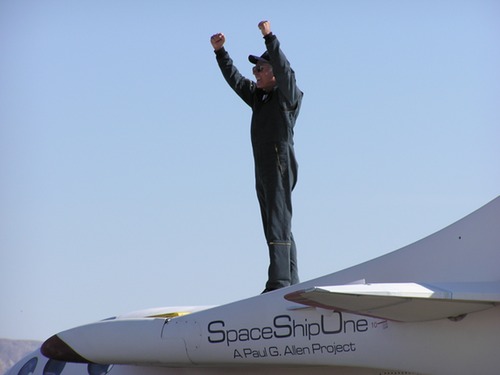
Pilot Mike Melvill stands atop SpaceShipOne after flying the vehicle into space for the first time on June 21, 2004. (credit: J. Foust)
Ten years ago this morning, a small rocket-powered vehicle with a single test pilot aboard appeared to open a door into the future. SpaceShipOne, carried aloft by its carrier aircraft, White Knight, detached from the plane, fired its hybrid rocket motor and soared to an altitude just above the Kármán line, the 100-kilometer boundary widely adopted as the “beginning” of space. SpaceShipOne then glided back to a safe landing at the Mojave Air and Space Port, entering history as the first privately-developed and -funded crewed vehicle to go into space.
That flight, and the two that followed in September and October 2004 that won the $10-million Ansari X PRIZE, appeared to open a new era in commercial spaceflight. It was supposed to be one where people would fly on a regular, even frequent, basis for tourism, research, or other reasons. Yet, there hasn’t been a commercial suborbital human spaceflight since Brian Binnie piloted SpaceShipOne on its final, prize-winning flight on October 4, 2004. Had you told nearly any one of the thousands who traveled to Mojave to see SpaceShipOne’s flight ten years ago that there would be such a long gap in suborbital human spaceflight, you might have been laughed off the airport grounds.
People have written a lot about this long gap in suborbital spaceflight, and a thorough examination of the causes is beyond the scope of a single post. Virgin Galactic has gone through an extended technical development, including a recent switch in hybrid rocket motors; it now plans to begin flights late this year, about seven years later than its original plans announced in September 2004. XCOR Aerospace’s progress has been hindered at times by limited funding, as Forbes recently reported, although the company announced last month it raised more than $14 million in a Series B funding round that should allow it to bring the Lynx to market. Blue Origin, meanwhile, keeps its plans under tight wraps; it would seem that founder Jeff Bezos, who is also funding the 10,000-Year Clock, is not in a particular rush.
It’s a far cry from ten years ago, when it appeared that SpaceShipOne and other vehicles under development would soon usher in a new era of low-cost suborbital human spaceflight. For a more comprehensive review of the history of SpaceShipOne and its successors, I just published Waiting for Launch: A Decade of Suborbital Spaceflight Dreams as a Kindle ebook for just $2.99. The book is a collection of articles from The Space Review from early 2003, when SpaceShipOne was unveiled, to the present day, with updated introductions for each article as well as a new introduction and conclusion. It is not the definitive history of this industry, but it does offer a series of snapshots to show how it has developed—or not—over the last decade.

Leave a Reply